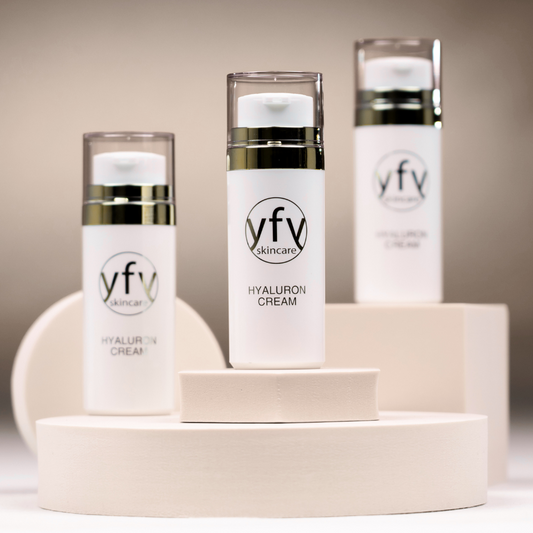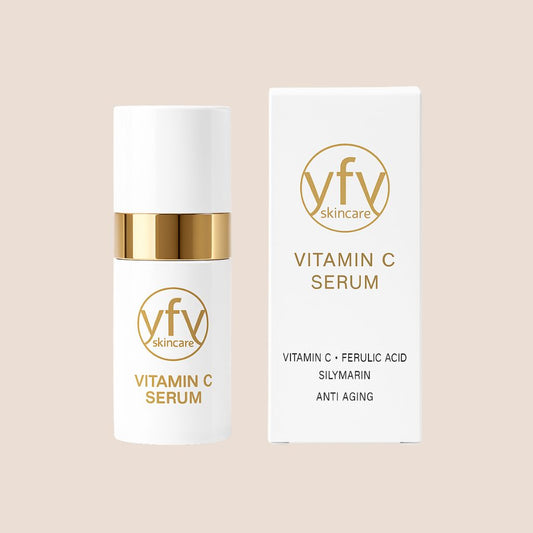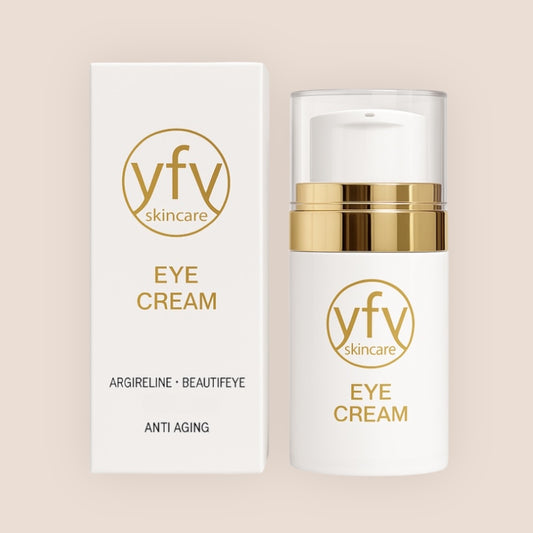
Hyaluronic acid - the wonder weapon
shares
The Hyaluronic acid
As an active ingredient in medicine, cosmetics and beauty treatments, hyaluronic acid has become indispensable. As a natural substance that occurs in the entire connective tissue of the human body and is formed by fibroblasts, it is able to store an enormous amount of water. However, production in the body decreases with age, especially in the skin and joints. With the use of hyaluronic acid in creams, the skin's water reservoir can be replenished quickly so that it has more resilience and elasticity. However, the positive effect depends on various factors, including the right molecule size.What is hyaluronic acid?
Hyaluronic acid is a polysaccharide that is found almost everywhere in the body, including the skin, bones, synovial fluid, cartilage and the vitreous body of the eye. When combined with water, it forms a gel-like material that acts as a lubricant and keeps the skin elastic.
In medicine, the active ingredient established itself early on and is used to treat joint diseases and arthrosis. In cosmetic surgery, hyaluronic acid is primarily used for wrinkle injections and for lip and breast augmentation. It is also increasingly used in cosmetics, is contained in creams, gels and ointments, mostly with the aim of improving the moisture content of the skin so that it looks fresher, plumper and firmer.
Natural hyaluronic acid
As a natural substance, hyaluronic acid has water-binding, viscoelastic, wound-healing and smoothing properties. In the human organism, the polysaccharide is assembled from individual building blocks by the body's own enzymes and forms a complex system for the enormous water binding and storage. This ensures the elasticity of the skin as well as the stability of the joints and their smooth functioning. As a natural substance, hyaluronic acid has virtually no side effects or risks when absorbed through the skin. It was first discovered and isolated in 1934 by biochemists John Palmer and Karl Mayer. The first hyaluronic acid preparations came onto the market in the 1980s, at that time still from animal sources, while today the active ingredient is obtained by fermentation.How does hyaluronic acid work in the body?
The building blocks of connective tissue include collagen, elastin and hyaluronic acid. The latter forms the main component for the connective tissue between the skin cells and supports and fills it. Thanks to its ability to bind six times as much water, hyaluronic acid ensures the high moisture content in the skin.
Hyaluronic acid in creams
The upper skin layer can also be visibly tightened as a fermented active ingredient in a cream. For the cosmetics sector, hyaluronic acid is usually obtained through biotechnological processes and bacterial fermentation, with several filtration steps taking place. The fermentation is significantly purer than that of animal starting material that was used in the past.The effect depends on whether it is a long-chain, short-chain or cross-linked variant . A combination of all variants in one cream is ideal. This allows wrinkles and fine lines to be reduced, redness and pigment spots to be alleviated and skin texture to be refined.
High-quality hyaluron promotes the build-up of the collagen matrix, works against skin impurities and is a good make-up base, as the cream can be applied without a greasy film. Just a few minutes after applying the hyaluronic acid cream, the skin feels plumper and firmer, has a fresh complexion and lastingly refines the pores. Wrinkles and lines are visibly filled and after regular use, the dryness lines around the eyes disappear. Products that combine hyaluronic acid with other active ingredients, including selected plant extracts, aloe vera and bisabolol, are excellent.
Differences in long-chain, short-chain and cross-linked hyaluronic acid
Hyaluronic acid is available in cosmetics in various forms, with the molecular size playing a particularly important role in determining how quickly the effect occurs. It is given in kilodaltons (kD) and has proven to be useful when specifying the size in order to distinguish between high-molecular and low-molecular hyaluronic acid. Long-chain and short-chain compounds have proven themselves. Long-chain hyaluronic acid has a high molecular mass of 1,500 kD and forms a moisturizing film on the surface of the skin, while short-chain hyaluronic acid has a low mass of less than 50 kD and is better stored in the connective tissue.The short-chain variant penetrates deeper into the epidermis and fills up the layers there. At the same time, it stimulates the body's own hyaluronic acid production. The long-chain variant supplies the upper layer of skin with moisture and has an anti-inflammatory effect. Another form is the cross-linked variant, which binds water and replenishes the skin's moisture depots. A mixture of all three variants is advantageous, so that both the upper and the lower skin layer are supplied with moisture. Low-molecular hyaluron has a better long-term effect, while high-molecular hyaluron has a quick and visible effect.
Benefits of hyaluronic acid in creams
Hyaluronic acid is much more effective in creams than in dietary supplements in the form of capsules and powder. With the composition of short- and long-chain hyaluron, the cream acts on the skin's surface and also penetrates into the deeper layers to plump them up. Anti-aging creams containing hyaluronic acid work effectively and quickly, especially in areas where wrinkles quickly form, including on the face and around the eyes, while the combination of molecular sizes also guarantees long-term effects. The advantages of creams with long-chain, short-chain and cross-linked hyaluron are shown by the following positive properties:- refines and rejuvenates the complexion
- tightens wrinkles and lines and fills them in again
- provides the skin with more moisture
- stimulates the natural production of hyaluronic acid
- addresses the upper and lower layers of the skin
- Fast and visible effect thanks to long-chain hyaluronic acid
- Long-lasting effect thanks to short-chain hyaluronic acid
- binds water through cross-linked hyaluronic acid
- Reduces redness and skin imperfections
- lightens pigment spots
- promotes collagen formation
How does hyaluronic acid help reduce wrinkles?
With the ability of hyaluronic acid to bind large amounts of liquid, it ensures a firm, smooth and fuller appearance in the skin and between the cells. As soon as the body's own production decreases, it is therefore advisable to absorb the active ingredient through the skin with an anti-aging cream and to increase the moisture content of the skin layers again.
The wrinkling
Wrinkles form with age for a variety of reasons. Predisposition, nutrition, lifestyle and external influences such as UV radiation, stress and environmental pollution play a major role. A distinction is made between static, dynamic and actinic folds, the latter being creases.
Static wrinkles form independently of facial expressions and are permanent, while dynamic wrinkles form due to facial expressions, skin aging and gravity. Wrinkles are caused by UV radiation, especially on the face, neck and décolleté. Natural skin aging begins from the age of 25 with the reduced production of hyaluron, collagen and elastin. The skin loses moisture, tone and elasticity and forms lines and wrinkles that deepen over time. Since the skin consists of three skin layers, with the upper one constantly being renewed, this can be positively influenced by a high-quality cream. By combining different types of hyaluronic acid and molecular sizes, it is also possible to reach the dermis directly underneath, in which the network of collagen fibers is located and gives the skin more elasticity.



